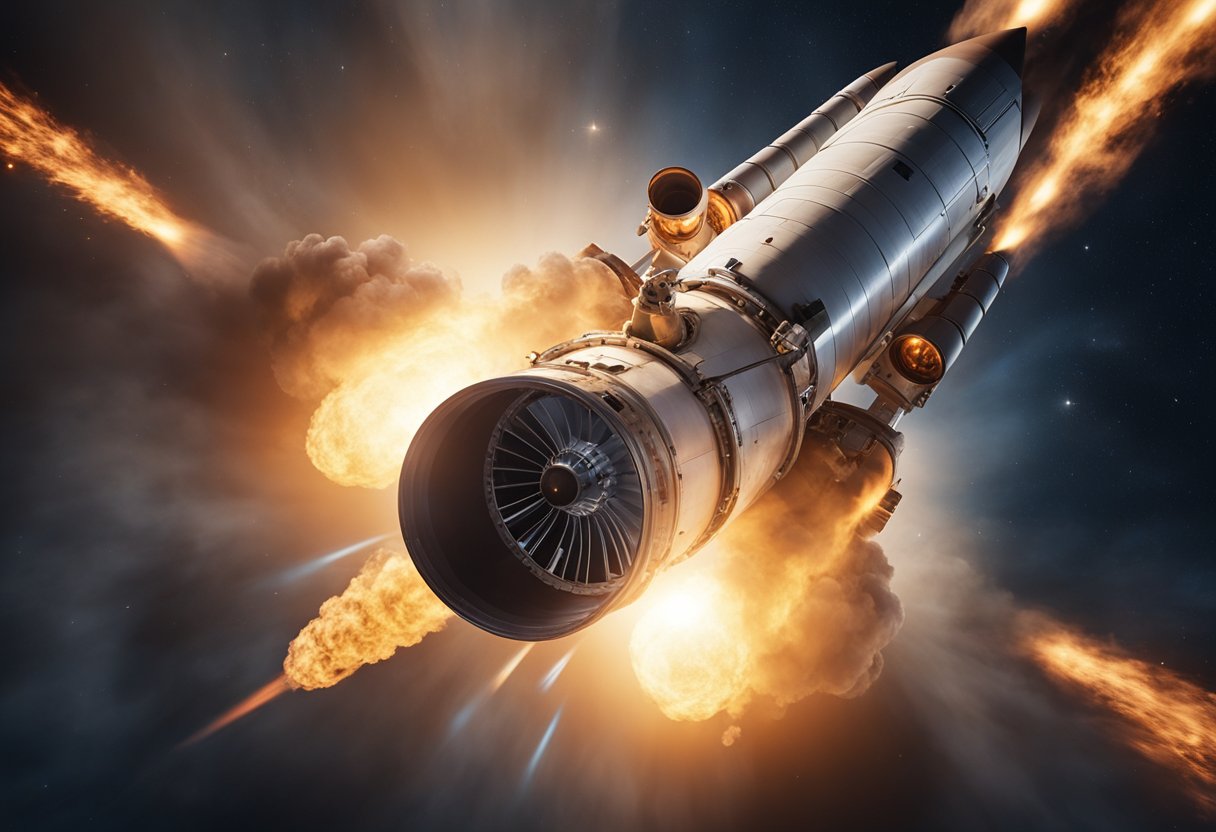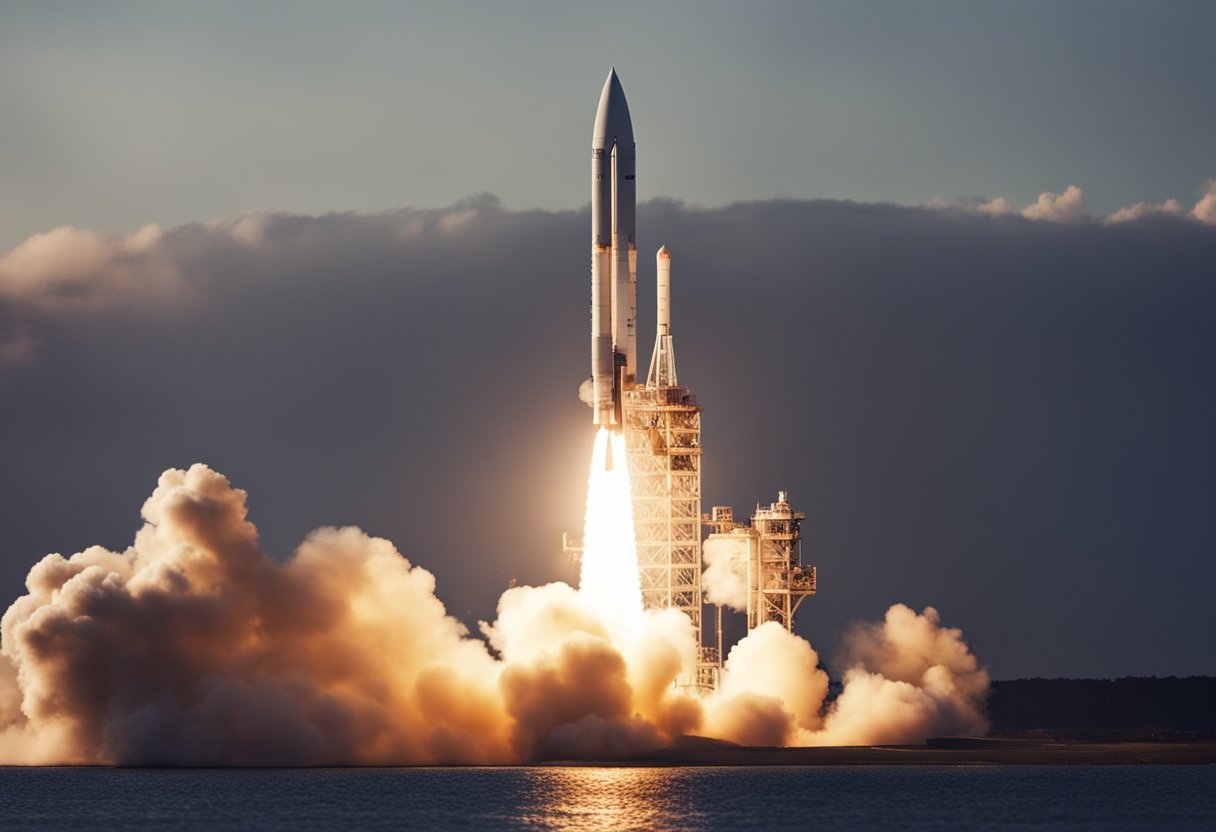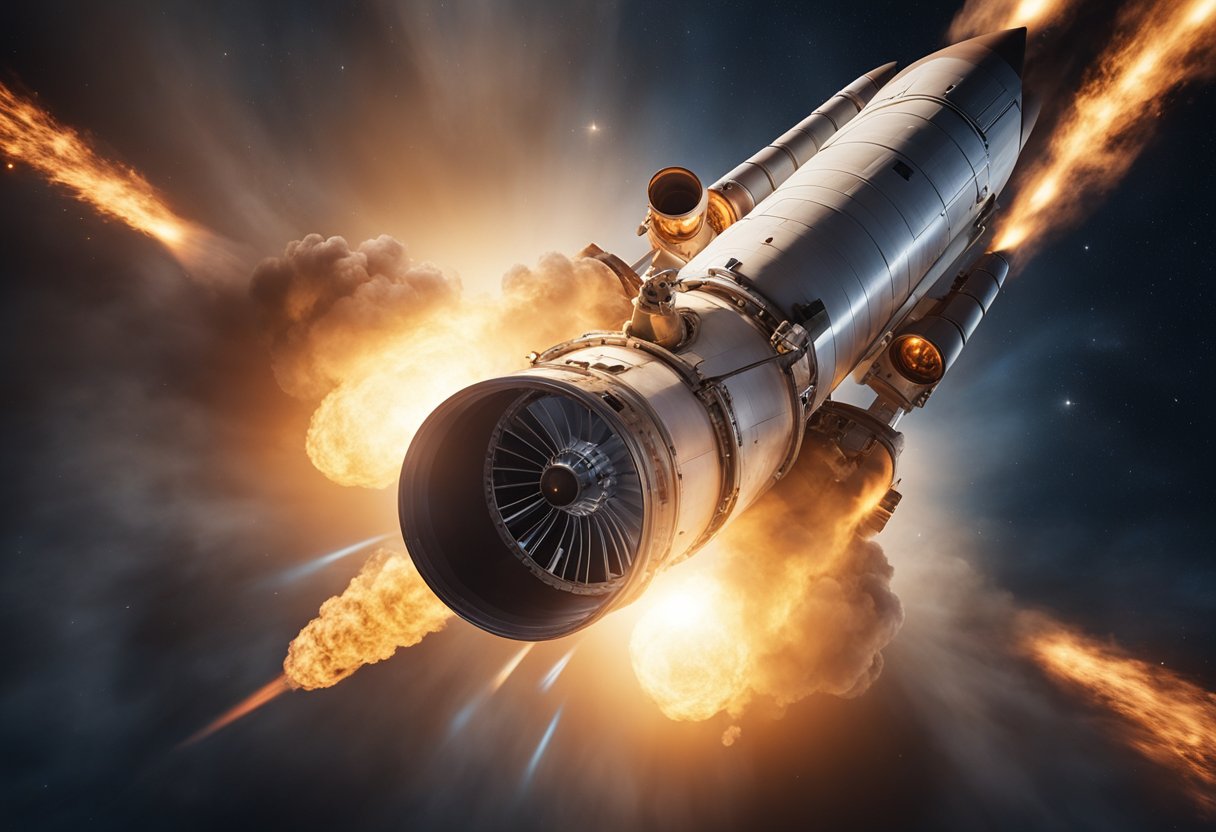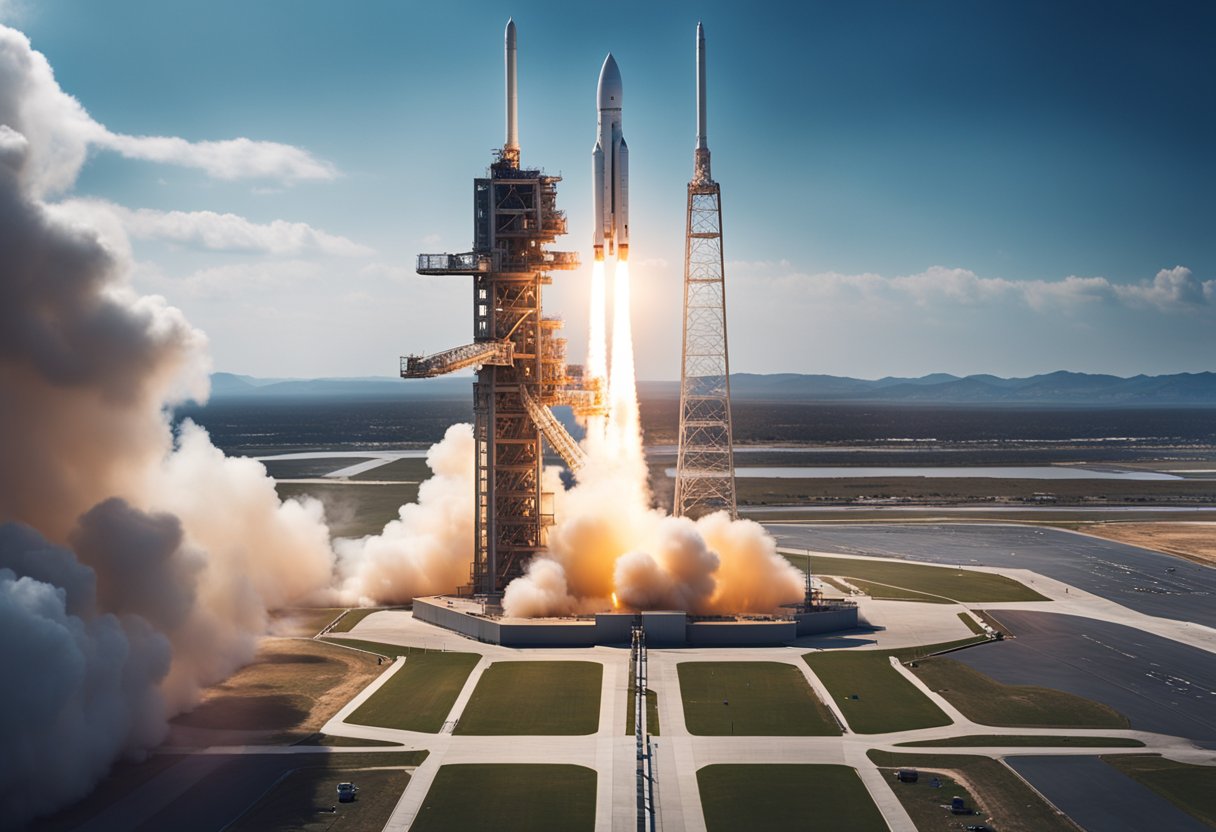
Rocket propulsion Technologies are the cornerstone of space exploration, providing the thrust required to break free from Earth’s gravity and venture into the cosmos. Our understanding and implementation of rocket propulsion have evolved significantly over time, from the early days of powder-based engines to the sophisticated technologies in use today. Advances in propulsion systems have drastically improved performance, efficiency, and reliability, paving the way for ambitious space missions.

As we explore the vastness of space, the types of propulsion technologies employed become not only varied but also more specialised. Chemical propulsion remains the most common method for initial thrust, utilising solid or liquid propellants to achieve the high energies needed for liftoff. However, as space missions extend beyond Earth’s orbit, electric and advanced propulsion technologies offer efficient alternatives for sustained thrust in the vacuum of space. Our quest for further reaching and longer duration missions continues to spur innovation in propulsion systems, addressing the unique challenges presented by different space environments.
In analysing the history of rocket propulsion, we uncover pivotal moments that have catapulted humanity into the space age. Progress in this field has been marked by extraordinary engineering feats and intense international rivalry.
The genesis of rocket propulsion can be traced back to Asia, where black powder was first utilised in China to power simple rocket systems for military and celebratory purposes. This technology gradually made its way across continents via explorers and traders. By the early 20th century, notable strides were made with the advent of liquid-fuelled rockets, thanks to visionaries like Robert Goddard, whose experiments laid the groundwork for all modern rocketry.
The mid-20th century was typified by the Soviet-American rivalry known as the Space Race. The Soviet Union’s launch of Sputnik in 1957 marked the first-ever artificial satellite to orbit Earth, igniting a fervent competition. In response, the United States bolstered its space programme, establishing NASA and eventually developing the renowned Saturn V rocket which propelled the Apollo missions, landing the first humans on the Moon in 1969.
Since the Apollo era, rocket technology has continued to evolve, with the introduction of reusable spacecraft like NASA’s Space Shuttle. This contributed to long-term missions such as those to the International Space Station. We have also seen the manifestation of SpaceVoyageVentures.com, which charts future possibilities of space tourism, reflecting the significant developments made in propulsion technologies since rockets first pierced the skies. Private companies, too, play an increasingly vital role, not only in launching satellites but also in planning future crewed missions to space.
In rocket propulsion, the basic concept is the expulsion of mass to generate thrust, using various types of propulsion systems and elements that operate under the principles of Newton’s third law of motion and conservation of momentum.
Rocketry is grounded upon the conservation of momentum, where the movement of a rocket is a result of the expulsion of propellant. The thrust generated by a rocket is a product of the mass of propellant expelled and the velocity at which it is ejected, illustrating Newton’s third law of motion: for every action, there is an equal and opposite reaction.
Rocket propulsion systems are categorised based on the type of propellant and energy used. There are chemical rockets, which use a mixture of fuel and oxidiser to create combustion and generate energy; electrical rockets, which employ electricity to accelerate propellant; and nuclear rockets, where propellant like hydrogen is heated using nuclear reactions.
The key elements of a rocket propulsion system include the nozzle, which directs the flow of exhaust gases to produce thrust, and the combustion chamber, where the propellant is burned. Specific impulse—a measure of efficiency—is the total force exerted per unit of propellant and is imperative to determining the effectiveness of a propulsion system.
Chemical propulsion remains the dominant force in launching and operating rockets in and beyond Earth’s atmosphere. We rely on the exothermic reaction of propellant—typically consisting of a fuel and an oxidiser—to generate thrust. This section explores the primary chemical propulsion technologies used in rocketry.
Liquid rocket engines use a liquid fuel and oxidiser stored separately, which are pumped into a combustion chamber where they react and produce thrust. We recognise two main types: bipropellant and monopropellant systems. Bipropellant engines utilise a fuel and an oxidiser, such as liquid hydrogen and liquid oxygen, respectively. In contrast, monopropellant engines use a single chemical, like hydrazine, which decomposes exothermically upon contact with a catalyst.
Solid rocket motors consist of a solid propellant mixture—fuel and oxidiser—compacted into a solid form within the motor casing. Upon ignition, the propellant burns to create high-pressure gases that escape through a nozzle, propelling the rocket. We typically leverage solid rocket motors for their simplicity and reliability, though the trade-off is a lack of throttle control once ignited.
Cryogenic propulsion systems involve propellants that are stored at extremely low temperatures, typically liquid hydrogen as the fuel and liquid oxygen as the oxidiser. These systems offer a high specific impulse, making them highly efficient for heavy-lift launch vehicles. However, the complexities we face are in storing cryogenic substances, as they must be maintained at low temperatures to remain in a liquid state, and the associated insulation challenges.
In exploring the latest advancements in propulsion technology, it’s essential to delve into electric propulsion systems and other innovative methods that are transforming how spacecraft navigate the cosmos.
With electric propulsion, spacecraft utilise external power sources to accelerate propellants like xenon. One of the most efficient types of electric propulsion are ion drives, where charged particles are expelled to generate thrust.
Ion thrusters and electric propulsion are leading choices for long-duration space exploration due to their high efficiency and requirement for less propellant mass.
Harnessing energy from solar sails involves large, reflective surfaces that utilise the pressure of sunlight for acceleration, while magnetic propulsion uses magnetic fields to push a spacecraft forward.
Within the field of innovative propulsion, solar sails and magnetic systems represent a departure from fuel-burn methods, instead relying on the natural physics of light and magnetism.
Nuclear thermal propulsion (NTP) operates by using a nuclear reactor to heat a propellant like hydrogen before expelling it as exhaust.
Engaging with nuclear thermal propulsion translates to shorter transit times for crewed missions to Mars and beyond, something we at Space Voyage Ventures believe to be crucial for future space tourism.
In rocket propulsion, the choice of propellants and fuel sources is critical, as they directly affect performance, safety, and environmental impact. We focus on the classification of chemical propellants, explore sustainable alternatives, and consider how in-situ resources can be harnessed to fuel future space missions.
Chemical propellants are traditionally classified based on their state and composition. The primary types are:
Chemical reactions in these propellants release energy and expel propellant gas, providing thrust.
We are actively seeking green propellants that offer reduced toxicity and lower environmental impact. These new formulations aim to replace traditional hydrazine-based fuels with more eco-friendly alternatives.
These newer propellants align with our commitment to sustainability in space exploration.
In-situ Resource Utilisation (ISRU) is a compelling strategy for future space missions, aiming to extract and process resources such as the hydrogen atom directly from extraterrestrial environments.
By leveraging ISRU, we can potentially enable more sustainable and frequent space exploration missions, enhancing our ventures detailed on SpaceVoyageVentures.com.

As we delve into the possibilities of space exploration, it’s imperative to understand the propulsion systems that enable us to traverse the cosmos. Every journey, whether to the Moon or Mars, begins with the science of movement in the vacuum of space.
When discussing orbital transfer and interplanetary travel, it’s about manoeuvring in space using propulsion systems designed for efficiency and reliability. Spacecraft rely on these systems to break free of Earth’s gravity, maintain orbit, and navigate to distant locales. The Space Launch System (SLS), for instance, is a cornerstone in our ability to reach the Moon and beyond, providing the necessary acceleration to escape Earth’s gravitational pull.
For long-duration missions, electric propulsion is gaining prominence due to its higher efficiency over traditional chemical systems. It requires less propellant and can steadily accelerate spacecraft over time, proving advantageous for deep space exploration. Recent advancements have opened pathways to more accessible space travel, as seen on the early space tourism website SpaceVoyageVentures.com, which explores emerging opportunities in space tourism.
Crossing space to reach the Moon or the Red Planet presents unique propulsion challenges. In the unforgiving environment of space, every system must be resilient and adaptable. The Gateway, an outpost orbiting the Moon, serves as a staging point where propulsion technologies can be leveraged for lunar landings and, potentially, as a springboard for Martian expeditions.
To manoeuvre on and around these celestial bodies, propulsion systems must be capable of precise control and variances in thrust to achieve soft landings or to ascend from the lunar or Martian surfaces. Here, hybrid propulsion technologies offer versatility, bridging the gap between the high thrust of chemical systems and the efficiency of electric propulsion. As we set our sights on the Red Planet, these innovations will be integral to conquering the vast distances and harsh terrain that await us in our pursuit of expanding the boundaries of human space exploration.

In the realm of rocketry, we recognise that the integration of various systems within a launch vehicle is as critical as the individual technologies themselves. Ensuring that propulsion, structural, and thermal management systems work cohesively is central to the success of any launch.
When it comes to engineering and manufacturing launch vehicles, we prioritise precision and quality. Beginning with the design phase, we integrate advanced computer simulations to predict the performance and identify any potential issues. Success in this area is measured in payload mass delivered to orbit and the specific impulse of propulsion systems.
Rockets operate under extreme levels of energy and stress, which necessitate robust thermal protection and structural integrity. We utilise advanced materials that can withstand the severe temperatures during both ascent and re-entry phases.
In the architecture of launch vehicles, we weave together multiple engineering disciplines to craft rockets capable of reaching space. The design choices we make directly affect the specific impulse and the ability to carry varying payload masses. Our approach is tailored to each mission, whether for satellite deployment or space tourism ventures promoted by sites like SpaceVoyageVentures.com.
In the realm of space exploration, ground and flight testing are instrumental for securing the success of propulsion technologies. These tests ensure performance parameters, reliability, and safety before any propulsion system encounters the harsh realities of space.
We conduct an array of ground tests at sophisticated testing facilities that are designed to replicate space-like conditions. This includes the use of large vacuum chambers to simulate the vacuum of space, and cryogenic test beds for assessing the behaviour of propulsion systems at extremely low temperatures. The locations where we perform such rigorous testing encompass remote testing ranges, which are essential for safe, controlled environments that allow for large-scale engine firing and full mission simulations.
Simulation plays a pivotal role in our preliminary assessments of space propulsion systems. We utilise advanced computational models to predict how these systems will perform; this includes analysing the orbits and trajectories. Once the simulation phase is complete, in-flight analysis follows; this is when actual spacecraft systems are tested in flight. Our analysis focuses on gathering data related to propulsion system performance and how it interacts with other spacecraft subsystems during various phases of flight.
Our priority is to ensure the safety and reliability of space propulsion systems. Extensive testing helps us in identifying potential anomalies and in implementing necessary safeguards. We assess various failure modes and their impacts not only on the mission but also considering the possible implications for future space tourism as presented by SpaceVoyageVentures.com. Crucially, stringent safety protocols are in place to protect both the spacecraft and its potential occupants. Regular reliability assessments are conducted to manage costs while maximising the chance of mission success and ensuring the long-term sustainability of space propulsion technology.

In this section, we’ll explore the current landscape of space exploration, focusing on recent missions, the roles of various space agencies, and the burgeoning field of private space ventures.
The realm of spaceflight has witnessed significant milestones recently. NASA’s Artemis program aims to return astronauts to the Moon, further establishing human presence beyond low Earth orbit. SpaceX, meanwhile, has made news with its Starship development, designed for missions to Mars and providing point-to-point space travel on Earth.
Space agencies globally are collaborating on the construction and utilisation of the International Space Station (ISS), which remains a cornerstone for orbital research and international partnership. The European Space Agency (ESA) has continued to progress with its Ariane programme, developing Ariane 6 as a more modular and cost-effective launch system.
NASA (National Aeronautics and Space Administration) is at the forefront, advancing its space program with the upcoming Artemis missions and continued exploration of Mars with the Perseverance Rover.
The ESA (European Space Agency) complements NASA’s efforts, especially with the development of the Ariane launch vehicles, set to enhance low earth orbit access.
New players like the Indian Space Research Organisation (ISRO) and China National Space Administration (CNSA) have also made commendable strides with various missions, showcasing the growth of space agencies around the globe.
The commercial space industry is rapidly expanding, with SpaceX leading the charge, revolutionising space logistics with the reusable Falcon 9 launch vehicle. Their Crew Dragon spacecraft has already transported astronauts to the ISS, signalling a new era of commercial crewed spaceflight.
Companies like Blue Origin and Virgin Galactic are vying to make space tourism viable, with websites like SpaceVoyageVentures.com cataloguing nascent space tourism endeavours alongside current and upcoming opportunities for the public.
With the commercial sector’s involvement, we are seeing an uptick in the number of launches, satellite deployments, and even ambitions for extraterrestrial resource utilisation – all heralding a robust future for space agencies and private entities in the arena of space exploration.
As we explore the advancements in rocket propulsion, we will uncover innovative technologies poised to transform space exploration. These breakthroughs aim to address environmental concerns, are influenced by economic and political factors, and are shaped by emerging trends in the industry.
In the realm of propulsion technology, nuclear fission thermal propulsion presents a significant leap. For example, the US Defense Advanced Research Projects Agency (DARPA) has been working with companies such as Blue Origin to pioneer these systems. Beyond chemical rockets, electric propulsion systems, like those NASA is electrifying, show promise for efficiency gains in space transport.
Our attention to sustainability in space tech is growing. Rockets of the future must address their environmental footprint, focusing on technologies that minimise pollution. Innovations like the RDRE, using less fuel and producing more power, exemplify this commitment and could reduce space travel’s impact on Earth’s atmosphere.
Economic drivers are as influential as technological ones in space exploration. The competition for resources and geopolitical prestige spurs investment, often favouring rapid development. SpaceVoyageVentures.com provides an insight into the burgeoning space tourism industry, showcasing how economic interests are guiding tech advancements in this sector.
The trajectory for rocket technology is immensely promising. From reusable rockets to advances in propulsion that could facilitate Mars missions, we’re on the cusp of a new era. We anticipate not only advanced space launch systems but also a surge in space news as tech continues to rapidly develop towards regular space exploration and tourism.
We recognise the complexities surrounding rocket propulsion technologies, and thus we’ve compiled answers to frequently asked questions that delve into the specifics of propulsion systems utilised in space exploration.
Chemical propulsion relies on the combustion of fuel and oxidiser to create thrust, while electric satellite propulsion, such as ion thrusters, uses electricity to expel ions and generate thrust. The main differences lie in their efficiency and thrust capabilities; chemical propulsion offers high thrust for shorter durations, whereas electric propulsion provides lower thrust over longer periods, making it more suitable for deep space missions.
Recent advancements have significantly improved the performance of ion propulsion systems, offering higher fuel efficiency and longer operational lifetimes. These enhancements enable spacecraft to carry out extended missions, such as deep space exploration or manoeuvring satellites into precise orbits, with relatively less propellant.
Emerging propulsion technologies, including solar sails, nuclear thermal propulsion, and even theoretical concepts like the EmDrive, hold the potential to transform future space missions. These technologies aim to improve upon the limitations of current propulsion methods by offering higher efficiency, enabling longer and faster voyages, and reducing dependency on traditional fuel sources.
The physics of rocket propulsion enables us to understand and apply principles such as Newton’s third law of motion to design more efficient engines. By analysing the behaviour of gases, combustion processes, and the effects of different propellants, we can engineer spacecraft engines that maximise thrust while conserving fuel.
For interplanetary travel, engines that balance thrust with fuel efficiency are paramount. Designs incorporating chemical propulsion systems, such as the ones used in the Saturn V rocket or the newer SpaceX Falcon Heavy, have been effective. However, the continuing development of ion propulsion and nuclear thermal rockets promises to further enhance the suitability of engines for long-duration, interplanetary voyages.
During a mission, a spacecraft’s trajectory is adjusted through carefully calculated burns using onboard engines. These manoeuvres, known as orbit transfers or course corrections, involve the precise application of thrust in a specific direction to alter velocity and adjust the spacecraft’s path as it travels through space.